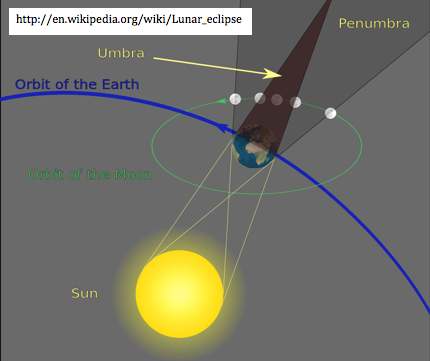
Lunar Eclipse
A few nights ago I noticed the moon was very red. Knowing that this was sometimes a precursor to a lunar eclipse I did some research and found out that there are 4 full lunar eclipses in 2014/15, the first was tonight, the second will be on October 8th and two more next year. They are all either fully or partly visible in and around the Pacific and the Americas, but not visible in Europe. A lunar eclipse occurs when the Sun and Moon align neatly on opposite sides of the Earth, so the Moon falls into the Earth’s shadow zone (umbra). During a lunar eclipse the moon doesn’t completely disappear but is shot through with a deep orange-red hue and is sometimes called a ‘blood-moon’.
The reason for the colour change is that the sunlight reaching the surface of the Moon, and therefore reflected back to Earth, is all in the longer wavelengths – the red end of the visible spectrum. The shorter blue wavelengths are more easily scattered by tiny air molecules (which is why the sky appears blue), and when the Moon is directly at the opposite side of the Earth from the sun, the light has to travel through a long stretch of the atmosphere to by-pass the Earth. Light travelling through space to the Moon at other times doesn’t pass through the Earth’s atmosphere at all, so the Moon reflects white light back to Earth and gleams silver-white.
In a full lunar eclipse, when the moon is in full shadow, you might expect it to be completely black and invisible, but this isn’t the case. It still receives some light because light can be reflected and refracted through the Earth’s upper atmosphere and literally go around corners, but the deeper the shadow, the darker red the Moon appears. The ship's imaging expert – Tim Fulton, took some lovely shots of the partial eclipse, one of which is pasted on the Joides Resolution Facebook page.
The science behind eclipses has been understood, and the timings predicted accurately, for hundreds of years, ever since Galileo Galilei persuaded the World of the truth of heliocentrism over geocentrism (the Sun versus the Earth at the centre of the Universe). This proved very useful to Christopher Columbus on his 4th, and final, ill-fated expedition to discover a westward passage to the Spice Islands in 1503. After many difficulties Columbus and his party became stranded on Jamaica for a whole year, during which the indigenous Arawak natives became a little tired of providing supplies for this party of audacious and demanding strangers. By shear good luck, Columbus was able to predict a lunar eclipse using the astronomical charts drawn up by Abraham Zacuto (Portuguese Astronomer Royal) which persuaded the Arawaks that it was better to support this powerful figure than upset him! Columbus and his men were eventually rescued in 1504.
On board the JOIDES Resolution, many of us stood on the deck at dusk, in anticipation of the eclipse, and shortly after the sun set in the west, the moon slowly forced an appearance through the opposing, misty horizon. In the Western Pacific, we were right on the edge of the penumbral zone (partial eclipse) so the Moon rose a lovely orange pink – but not dark red. However, an added bonus was to see Mars, just above the moon, at its nearest approach to the Earth in six years, and easily resolved into a disc through the Captain’s hurridly borrowed binoculars!
The true beauty of the moon came a little later, though. She shone in all her silvery glory with Mars riding high above like a herald. She shed a sparkling undulating wake of light out towards the ship, and no photograph could ever do justice to the sight. This is one memory, of many, that I will remember forever.
Slowly, silently, now the Moon
Walks the night in her silver shoon
(Walter de la Mare)